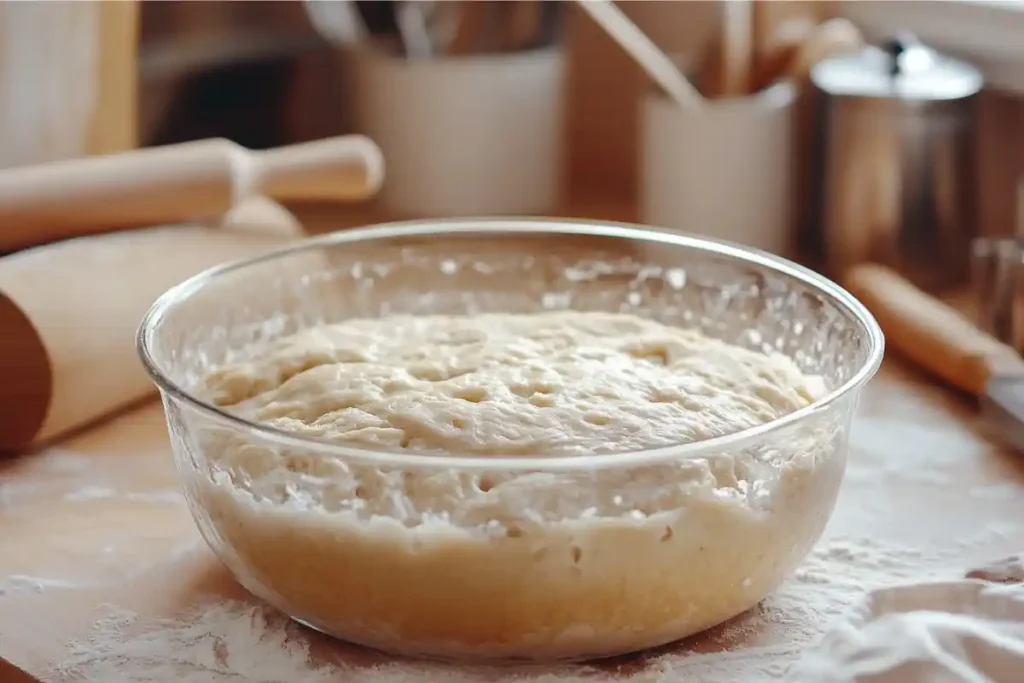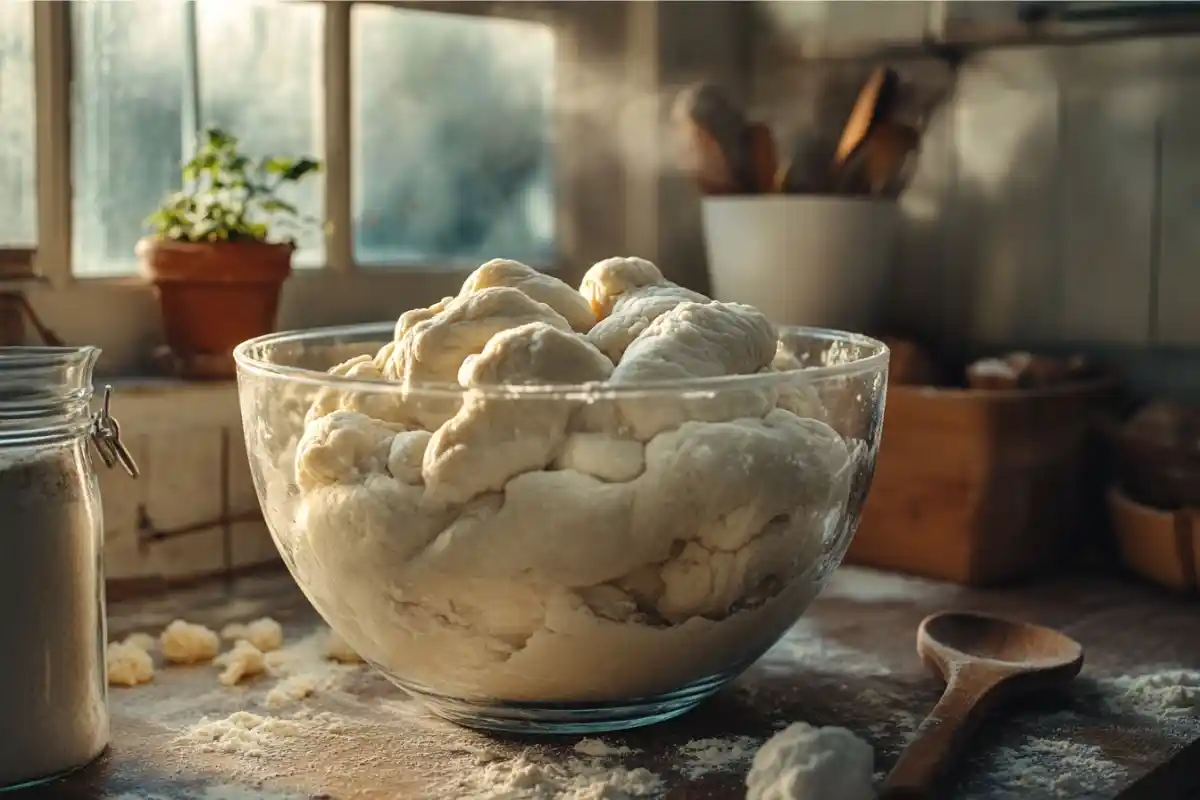Introduction
When it comes to baking sourdough bread, every little detail matters, from the type of flour you use to the container for fermenting your dough. One common question among bakers—newbies and experts alike—is, “Can I use a glass bowl for sourdough bread?” In this article, we’ll delve into the benefits of using glass bowls, explore alternative materials, and provide practical tips for selecting the perfect bowl for your sourdough-making journey. Whether you’re experimenting with your first starter or aiming to perfect a classic recipe, understanding your equipment will make a world of difference.
Introduction to Sourdough Bread Preparation
What is Sourdough Bread?
Sourdough bread isn’t your typical loaf. It’s a living creation made from flour, water, and wild yeast. Unlike bread with commercial yeast, sourdough rises through natural fermentation. This process gives it a tangy flavor and chewy texture that bakers love. While it’s an ancient method, it still requires patience, precision, and the right tools to succeed.
Why Bowl Selection Matters in Sourdough Making
The bowl you use plays a key role in the sourdough-making process. This is because it directly affects fermentation. A good bowl should be non-reactive, easy to clean, and large enough for rising dough. The dough’s flavor and texture could suffer if you choose the wrong material, like reactive metals. Moreover, the bowl’s size and material influence heat retention and moisture—both crucial for proper fermentation.
Picking the right bowl isn’t just a matter of preference; it’s essential for success. The next section will explore why many bakers prefer glass bowls and whether they meet expectations.
Can I Use a Glass Bowl for Sourdough Bread? Benefits Explained
Learn how glass bowls enhance the sourdough baking process

One great thing about glass bowls is that you can see through them. With glass, you can watch the dough rise and check for bubbles without touching it. This is especially helpful for beginners learning to spot when their dough has doubled. Knowing when the dough is ready helps you get perfect results every time.
Non-Reactive Nature of Glass
Another advantage of glass is that it doesn’t react with the dough. Unlike some metals, it won’t affect the sourdough’s natural flavor or texture. This ensures your bread keeps its tangy taste, just as it should. If consistency is important to you, a glass bowl is a solid choice.
Temperature Retention and Distribution in Glass Bowls
Glass bowls are also great at keeping the right temperature for the dough to rise. They hold and spread heat evenly, creating a stable environment for the fermentation process. This helps avoid problems like over-rising or under-rising, making glass bowls a reliable option for bakers.
For more on creative ways to use sourdough, check out this guide on sourdough garlic bread.
Alternatives to Glass Bowls

Stainless Steel: A Durable and Versatile Option
If you don’t have a glass bowl, stainless steel is a good alternative. It’s tough, lightweight, and easy to clean. Plus, it doesn’t react with sourdough, so your dough stays safe. However, you can’t see through it, so you’ll need to check the dough’s rise by removing the cover.
Plastic Bowls: Pros and Cons for Sourdough
Plastic bowls are another option because they’re light and inexpensive. While they don’t react with sourdough, some plastics might hold smells or stains over time. This could change the dough’s aroma. Additionally, plastic doesn’t hold heat as well as glass or steel, which can affect fermentation.
Ceramic Bowls: Traditional and Aesthetic Choice
Ceramic bowls are both beautiful and functional. They are non-reactive and hold heat well, similar to glass. However, they are heavier and can break more easily, which might make them less convenient for everyday baking. Still, if you want something stylish, ceramic is a great option.
For tips on baking with the right tools, explore this guide on sourdough bread bowls.
Tips for Choosing the Best Bowl for Sourdough
Size and Capacity Considerations
Picking the right-sized bowl for sourdough is crucial. The dough will often double or triple in size during fermentation, so your bowl must be large enough to hold this expansion. A small bowl can lead to messy spills, while an overly large one might not maintain consistent warmth. Ideally, choose a bowl that holds at least three times the dough’s starting size for the best results.
Material Safety and Compatibility with Sourdough
The bowl’s material is just as important as its size. Can I use a glass bowl for sourdough bread? Absolutely, and it’s one of the best options because it doesn’t react with the dough. Similarly, stainless steel and food-safe plastic can work but avoid metals that might affect the dough’s flavor. Keeping the material safe ensures your bread tastes just the way it should.
Ease of Cleaning and Maintenance
Another key factor is how easy the bowl is to clean. Glass and stainless steel bowls are dishwasher-friendly, making them simple to maintain. Plastic bowls might stain or retain odors, and ceramic bowls, though beautiful, may need gentle handwashing. Consider your cleanup preferences when picking the right bowl for your baking needs.
For more tips on baking tools, explore this guide on sourdough bread bowls.
Common Questions About Using Glass Bowls for Sourdough
Is Glass Safe for Long Fermentation?
Yes, glass is perfectly safe for long fermentation. Unlike reactive materials, glass won’t alter the dough’s flavor or texture. This is why so many bakers prefer glass when making sourdough. If you’ve been asking, “Can I use a glass bowl for sourdough bread?”, rest assured—it’s a great choice.
Can a Glass Bowl Break During Use?
Glass bowls are sturdy but can break if mishandled. To prevent accidents, use a thick, high-quality bowl. Avoid sudden temperature changes, such as placing a cold bowl in a hot oven, as this could cause cracks. When handled carefully, a glass bowl can last for years and become a trusted part of your baking routine.
Does Glass Affect the Flavor or Texture of Sourdough?
Glass doesn’t interfere with the natural fermentation process, so it won’t change the sourdough’s flavor or texture. It preserves the dough’s tanginess and soft texture, making it an excellent option for bakers who want consistent results.
For more creative sourdough ideas, you can explore our post on sourdough garlic bread.
FAQs
Do You Need to Cover the Bowl During Fermentation?
Yes, it’s essential to cover the bowl during fermentation to maintain the right environment. Covering the bowl keeps the dough from drying out and helps trap heat and moisture, which are critical for proper rising. You can use a damp towel, plastic wrap, or even a fitted lid, depending on the type of bowl. If you’ve been wondering, “Can I use a glass bowl for sourdough bread?”, rest assured—a glass bowl works perfectly with any of these coverings.
Can I Use Any Type of Glass Bowl?
Not all glass bowls are created equal. When choosing one, look for high-quality, thick glass that can withstand temperature changes. Avoid thin or decorative glass bowls, as they may crack under pressure or during cleaning. A sturdy glass bowl will last longer and be more reliable for sourdough baking.
What Are the Alternatives if I Don’t Have a Glass Bowl?
If a glass bowl isn’t available, other materials like stainless steel or food-safe plastic can be good substitutes. Just make sure they’re large enough and non-reactive. Ceramic bowls are also an option but may require extra care because they’re fragile. While glass is often the top choice, there are plenty of alternatives to get the job done.
Conclusion
Summarizing the Pros and Cons of Using Glass Bowls
Using a glass bowl for sourdough has clear advantages. It’s non-reactive, easy to clean, and allows you to see the dough as it rises. However, like any material, it has its limitations. Glass bowls can break if mishandled, and they may not be as portable as plastic or as lightweight as stainless steel. Still, the benefits far outweigh the drawbacks for most home bakers.
Final Recommendation for Home Bakers
So, “Can I use a glass bowl for sourdough bread?” Absolutely! Glass bowls are an excellent choice, especially if you want a safe, reliable, and visually helpful option for your baking. Whether you’re just starting out or refining your technique, investing in a high-quality glass bowl can enhance your sourdough-making experience.
Expert Tips for First-Time Sourdough Bakers
Preparing Your Workspace for Success
Before you start baking sourdough, set up a clean, organized workspace. Gather all your tools, including a large glass bowl, measuring cups, and a bench scraper. This preparation saves time and helps you focus on the process. If you’re asking, “Can I use a glass bowl for sourdough bread?”, this is a great time to ensure you have one ready. A well-prepared workspace makes the entire process smoother and less stressful.
Managing the Dough During Fermentation
Keep an eye on your dough as it ferments. Use the transparency of a glass bowl to monitor the dough’s rise without disturbing it. Make sure the bowl is covered to prevent the dough from drying out or forming a crust. Using a timer or a simple reminder can help you avoid over-fermentation, which can lead to a sour flavor that’s too strong.
Storing Your Sourdough Tools
Once you’re done, clean and dry your tools promptly to keep them in good condition. For glass bowls, avoid sudden temperature changes during washing to prevent cracks. Storing your tools in a designated area keeps everything ready for your next bake.
Why Sourdough Is Worth the Effort
The Unique Benefits of Baking Sourdough Bread
Sourdough bread is more than just a delicious food; it’s a tradition that connects you to an ancient craft. One of the most significant benefits is its flavor. The slow fermentation process develops a tangy, rich taste that can’t be matched by store-bought bread. Each loaf is unique, offering a mix of slightly sour and earthy notes that reflect the care and time put into its creation.
Beyond its flavor, sourdough has a chewy texture and a crisp crust that many bread lovers find irresistible. The long fermentation process gives it a structure that holds up well to spreads, soups, or even sandwiches. If you’ve ever made sourdough, you know the satisfying crackle it makes when sliced—a testament to its perfect crust.
Health-wise, sourdough bread is easier to digest than many other breads. The natural bacteria and yeast in the starter break down some of the gluten and phytic acid in the flour, making the nutrients more accessible. For people with mild gluten sensitivity (not celiac disease), sourdough can be a gentler option. Plus, it often has a lower glycemic index, helping to keep blood sugar levels stable.
Sourdough baking also offers a wonderful sense of accomplishment. There’s something deeply rewarding about starting with simple ingredients—flour, water, and salt—and turning them into a flavorful loaf. Each step, from feeding your starter to shaping the dough, adds to the experience. When you take that first bite, knowing it was made by hand, the effort feels entirely worth it.
Making Baking a Habit
While sourdough may seem intimidating at first, it becomes much easier with practice. The key is to create a habit of baking regularly. Start by picking a consistent day of the week to work on your sourdough. With repetition, you’ll become more familiar with the process, including how the dough should look and feel at each stage.
Having the right tools also helps build confidence. For instance, if you’ve ever wondered, “Can I use a glass bowl for sourdough bread?”, the answer is a resounding yes. A glass bowl lets you see the dough’s progress, which is particularly helpful for beginners. This visibility can teach you how your dough responds to time, temperature, and other factors, making you a more intuitive baker.
In addition, sourdough baking is a chance to be creative. Once you master the basics, you can experiment with different types of flour, add-ins like seeds or herbs, or even try shaping techniques. Every loaf is an opportunity to learn something new and express your personal style.
Finally, baking sourdough can be a relaxing ritual. Kneading the dough, shaping it, and watching it rise can be meditative. It’s a chance to slow down in a busy world and enjoy the simple pleasure of working with your hands. Plus, the smell of fresh-baked bread filling your kitchen is a reward in itself.

